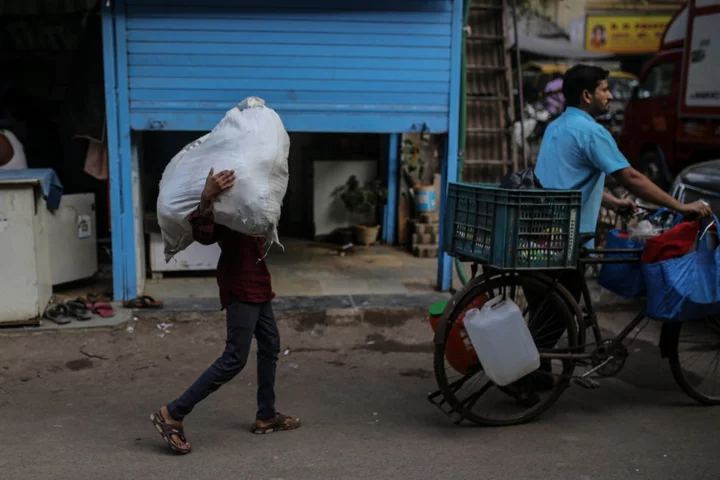India’s booming economy is the envy of other major markets. But beyond the hype and expectation, people who watch the country closely are flagging warning signs.
The nation is heading for a slowdown, analysts who cover it say, as rising inequality squeezes consumer spending among the poor — and the hundreds of millions in the middle class. The pessimism comes even after the latest growth figures blew past estimates last week, rounding off an expansion of more than 7% for the fiscal year.
“Consumer fatigue appears to be setting in,” said Kunal Kundu, an economist with Societe Generale SA in Bengaluru. The economy may slow “substantially,” he said.
Any cooling — especially one driven by inequality — would pose a challenge for Prime Minister Narendra Modi as he seeks a third term in general elections next year. It would also increase the chances the central bank, which decides on monetary policy this week, will cut interest rates earlier than expected.
And it would temper hope — at least in the short term — that India will do more to propel the global economy as powerhouses such as China slow.
India grew by 6.1% in the three months ended March compared to a year earlier, well beyond the 5% estimate of economists surveyed by Bloomberg, driven mainly by increases in services exports and government spending. It expanded 7.2% for the fiscal year through March, continuing a post-pandemic recovery that outstrips major peers.
But Nomura Holdings Inc., HSBC Holdings Plc, Standard Chartered Plc, Goldman Sachs Group Inc. and others say growth will decelerate this fiscal year, with Nomura seeing it falling to 5.5%. The banks pointed to other factors, such as the impact of rising borrowing costs on spending, and slowing global growth affecting exports.
SocGen and others say consumer demand will decline as the nation’s rich get richer but others struggle with the cost of living. That’s creating what’s known as a K-shaped recovery in consumption, where luxury items sell well but basic goods go in the opposite direction, Kundu said.
Sarmishta Sarkar, a 35-year-old manager at a multinational food and beverage company, is putting off buying a compact car that she could drive to the office instead of braving Mumbai’s notoriously crammed public transport.
“Saving is difficult when living costs themselves are this high,” she said. “I will wait until December.”
Private consumption fell 3.2% in the three months ended March from the previous quarter. This may be due to reduced spending by the urban middle class, which should come as a concern for the country’s growth, said Rupa Rege Nitsure, chief economist at L&T Finance, the commercial and personal finance arm of India’s largest construction company.
“It’s not a broad-based recovery,” she said, adding this means it will be difficult to sustain.
Even spending by the 65% of the population living in rural areas, a bright spot in the recent data after a strong harvest, is expected to slow if an El Niño weather pattern brings drought that disrupts the monsoon season, which plays a vital role in the lives of hundreds of millions of people who depend on agriculture.
Two-wheeler vehicle sales, a key gauge of rural demand, remain below their pre-Covid levels.
“When you look at volume growth, it’s very apparent that there has been more stress” in India’s hinterland compared to urban areas, Sanjiv Mehta, the outgoing managing director and chief executive officer of Unilever’s Indian arm, said in an interview in Mumbai. “It’s very understandable when you have this kind of inflation.”
One implication of a slowdown is likely to be on interest rates.
All 40 economists surveyed by Bloomberg forecast the Reserve Bank of India will keep the repurchase rate unchanged on Thursday, after it unexpectedly paused its tightening cycle in April. But Nomura economist Sonal Varma expects the central bank to start cutting rates in October and to lower them by a total of 75 basis points.
Another impact, at the margins, may be on Modi’s prospects in the 2024 polls. India needs growth of 8% to 8.5% annually to employ the 90 million new nonfarm workers that will join the workforce by 2030, a McKinsey report in 2020 said.
Despite the pessimism, there are many positives about India’s economy. The services sector is booming, while a manufacturing purchasing managers’ index reached a 31-month high in May. Tax collections hit a record in April, inflation is easing and foreign-exchange reserves are among the largest globally.
Even with the expected slowdown, India will still be the fastest-growing major economy in the world this year, according to International Monetary Fund projections. Germany is in recession, some observers expect the US to follow, and the IMF projects China will grow 5.2% in 2023.
HSBC raised its India growth forecast for the current fiscal year to 5.8% this week, up from 5.5%, saying GDP growth momentum has been “steady.”
And even if India slows in the short term, analysts remain bullish on its long-term prospects. “India is rising in the world order,” Morgan Stanley equity strategist Ridham Desai and colleagues wrote in a report on the country’s markets this month.
But that’s all little consolation to Sanjay Kumar Mishra, a 40-year-old security guard at a gated community on the outskirts of Mumbai. He shares a 10 square-meter room with five others, but there’s only three in it at any time because people work two shifts.
Mishra’s wages have hardly changed since the before the pandemic even as inflation surged. He earns about 12,000 rupees ($145) a month. These days, he sends less money home to his family in a village in the northern state of Uttar Pradesh. And they, in turn, spend less.
“There’s no point arguing on salary,” he said. “Somebody else is always ready to work for a thousand rupees less.”
--With assistance from Chris Kay.

